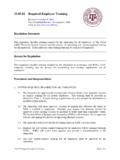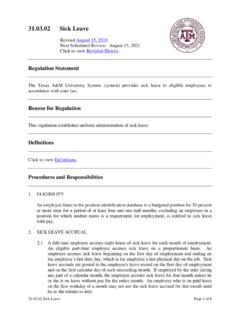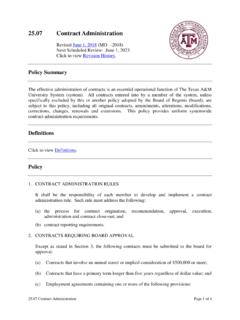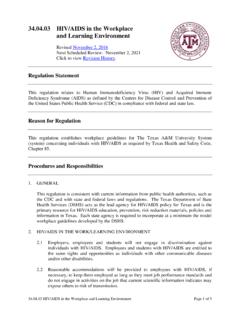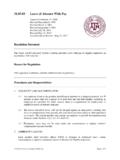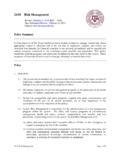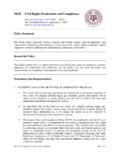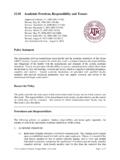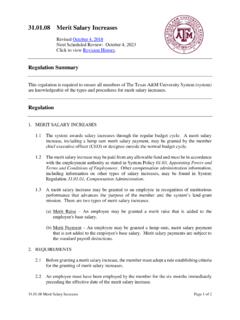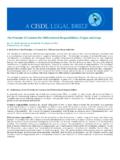Transcription of 31.01.01 - Compensation Administration
1 Compensation Administration Revised November 15, 2016. Next Scheduled Review: November 15, 2021. Click to view Revision History. Regulation Statement The Texas A&M University System (system) is committed to providing excellence in education, research and service. The system shall maintain a Compensation program directed toward attracting, retaining and rewarding a qualified and diverse workforce. Within the boundaries of financial feasibility, employee Compensation shall be externally competitive and internally equitable.
2 Reason for Regulation This regulation provides guidance regarding Compensation Administration while establishing uniform Compensation practices. Procedures and Responsibilities 1. GENERAL. Total Compensation includes not only direct pay but also indirect Compensation including insurance and retirement benefits and time off programs. The Texas Legislature sets eligibility requirements for these benefits and programs based on the definition of regular employee. A regular employee is defined as working in a budgeted position at 50 percent effort (20 hours a week) or more for at least four and one-half months, excluding students employed in positions that require student status as a condition for employment.
3 Specific eligibility requirements for various programs appear in the appropriate policies and regulations. Position Categories The system categorizes positions into the following groups: (a) Board of Regents (board)-appointed positions are those specific positions identified in System Policy , Appointing Power and Terms and Conditions of Employment, as requiring appointment by the board. Compensation Administration Page 1 of 7. (b) Academic positions are traditional faculty positions, the occupants of which either have been granted tenure or are on the established tenure track, plus other faculty equivalent positions (such as lecturer, instructor, visiting professor, teaching assistant, etc.)
4 That are paid from funds budgeted for teaching salaries and whose duties include the teaching of academic courses for credit or the direction of such teaching. (c) Research and extension positions involve the performance of research and/or extension (including extension teaching) responsibilities at a professional level, including positions charged with directing such activities. This category may include positions with traditional faculty titles and unique title codes to differentiate them from similarly titled positions in the academic category.
5 (d) Professional and Administration positions have a high degree of executive, professional and/or administrative responsibility, as those terms are defined in the Fair Labor Standards Act (FLSA), and typically meet the FLSA job duties test for exemption. Positions in this category generally require a baccalaureate degree or the equivalent combination of education and experience. (e) Support, technical and service positions involve the performance of staff support, clerical, craft, trades, technical, maintenance or service activities or, as a primary responsibility, the direct supervision of individuals performing such activities.
6 Most, but not all, of these positions are nonexempt under FLSA standards. (f) Special category positions are those that, because of their unique organizational placement, function or other characteristics, clearly do not fit any of the five preceding categories of employment. (g) Wage positions are temporary positions that do not appear in the budget and are funded from a lump-sum budget category. These positions are of two types: (1) Student wage positions require student status as a condition of employment. (2) Other wage positions are created to accommodate temporary labor needs and can be given a title from any of the major categories noted above.
7 Terminology Promotion When an individual moves from one position to another position requiring higher qualifications, a higher rate of pay and a title change. Demotion When an individual moves from one position to another position having a lower pay range and/or less senior title requiring less education, experience and responsibility. Reclassification/Re-evaluation When the job duties of a position are re-evaluated and the position is assigned to a new classification. A position that is re-evaluated may be assigned a lower or higher salary range and/or title.
8 In such cases, the Compensation Administration Page 2 of 7. position occupant will concurrently be judged to have been promoted, demoted and/or re-titled. Transfer When an individual moves from one position to another, both of which are assigned the same salary range, title or organizational level. Salary Actions Across-the-board increase When uniform salary increases are granted within prescribed guidelines, usually by legislative enactment, without regard to individual merit of employees. Merit salary increase An increase granted to an individual in recognition of meritorious job performance, as recorded in a formal and documented performance appraisal process (See System Regulation , Performance Evaluations for Nonfaculty Employees).
9 The annual performance evaluation is required and should be a factor along with other criteria established by each member for any decision concerning the award of a merit increase. Merit increases are governed by System Regulation , Merit Salary Increases. Equity adjustment A salary adjustment made for the purpose of establishing a fairer and more comparable relationship between the salaries of two or more employees in the same job title or grade relative to experience, education and/or certification. Requests for equity adjustments should include documentation justifying the increase and indicating the source of funding.
10 Market adjustment A salary increase granted to establish equity/competitiveness with salaries paid in the relevant labor market, as documented by approved survey data. 2. NON-DISCRETIONARY Compensation . Minimum Wage The system will establish wage rates in compliance with federal and state minimum wage regulations. See System Regulation , Fair Labor Standards. Hazardous Duty Pay and Longevity Pay State employees are eligible for hazardous duty and longevity pay in accordance with System Regulation , Longevity and Hazardous Duty Pay.
